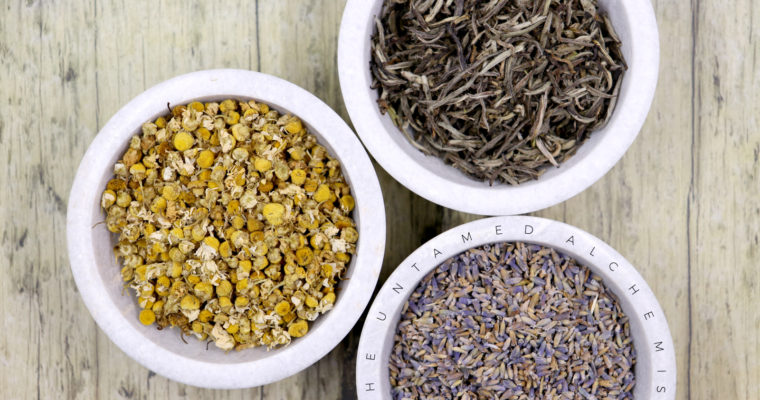More often than not, when we think of Chamomile, we think of the herbal Chamomile tea used to encourage sleep.
But Chamomile bears many additional therapeutic properties–and lends itself to more varied applications.
Aromatherapy offers us two unique Chamomile essential oils: German Chamomile (Matricaria recutita) and Roman Chamomile (Chamaemelum nobile), it’s somewhat lesser known sister. The essential oils from each of the two Chamomiles provide us with powerful tools for a multitude of issues and ailments.
Broadly, the Chamomile family includes plants of the Asteraceae family. The root of the name Chamomile–commonly translated to “ground apple” or “earth apple”–relates directly to Roman Chamomile’s tendency to smell like fresh, crisp apples.
Flowers typically bloom from early to mid-summer, though their season can be extended where plants thrive; the flowering heads are used to distill their essential oils.
Delicate annuals, German and Roman Chamomile have distinct differences in their appearances, though they hold similarities in many of their therapeutic and energetic actions. In German Chamomile, we find small, delicate flowers with a yellow to greenish-yellow center surrounded by individual white petals. Their appearance, tiny size, and tendency to bloom prolifically cause them to look like bright, abundant miniature daisies. Tiny, feathery leaves extend variously up the 6-24 inch stems.

Roman Chamomile also sports delicate, wispy leaves, though here we find flowers with white petals layered abundantly around the flower’s center–more showy and “puffy” than in the German counterpart. Often the flower’s center appears more greenish-white than yellow in nature. Sometimes the profuse petals almost obscure the flower’s center, giving Roman Chamomile an appearance more like a tiny chrysanthemum.
Much like the appearance of the respective Chamomile flowers are different, so, too, are the appearances of their essential oils.
Whereas Roman Chamomile is a clear, sometimes pale blue oil, German Chamomile delivers a dark, deep blue essential oil that often has a texture.
Both varieties prefer sandy, slightly acidic soil in which to grow. Where high temperatures consistently challenge them, they appreciate a small amount of shade to protect them.
Commonly linked to the Sun (for German Chamomile flowers have a decidedly sunny appearance), Chamomile finds itself inextricably linked to both the Solar Plexus and Throat chakras and to the sign of Leo.
Not surprisingly, many Sun gods find themselves associated with Chamomile flowers, though Chamomile connects with Venus, Water, and the feminine thanks to its cooling, nurturing nature. Indeed, the root of German Chamomile’s latin name, Matricaria, hearkens to the plant’s mothering, soothing tendencies (as well as its positive effect on menstrual cramps and the womb).
Magically, both Chamomiles align with peace, purification, tranquility, love (especially nurturing, motherly love), and luck.
Therapeutically, German and Roman Chamomile effectively address heat, inflammation, and spasm and serve as gentle tonics, relieving stress and nervous anxiety. German Chamomile offers exceptional support for skin, addressing everything from psoriasis and eczema to wound and scar healing. Aromatherapists look specifically to Roman Chamomile to heal digestive upset and calm menstrual cramps. Both varieties offer sedative effect, making them excellent choices for calming or sleep blends (as the long tradition of drinking Chamomile tea before bed suggests).
Prized as an anti-inflammatory, antispasmodic, and central nervous system sedative, German Chamomile also has powerful subtle energy associations: it calms feelings of anger and frustration, offers support in difficult situations, and reduces all energetic heat. Sedative and antidepressant, it is indicated where nervous irritability or restlessness exist in the spirit or the body.
Many of German Chamomile’s properties are anchored in its signatures (or the ways in which the truth about the plant–structure, aroma, colors, source climate, and the like–communicate its energetic, therapeutic, and subtle energy properties).
Association through the doctrine of signatures is best expressed in the example of German Chamomile as both the plant and its distilled essential oil offer ample, obvious signatures–from flower shape to oil and flower color–for consideration:
- The essential oil resulting from distillation of German Chamomile flowers is a rich, deep, dark blue color hinting at the oil’s unique cooling and anti-inflammatory properties. Not surprisingly, the oil is particularly effective when applied in a blend on the skin to heal wounds resulting from burns.
- The flowers are small and typically prolific in each plant; their size and number communicate a delicate, but thorough, effect in their therapeutic and energetic properties.
- Individual German Chamomile flowers have a yellow center surrounded by a series of white petals reminiscent of a star or sun, proposing a “sunny” disposition and making the essential oil a powerful ally in addressing the “blues”.
- Chamomile leaves are fine and feathery, suggesting an innate tenderness which the powerful, but gentle, essential oil assuredly possesses. In addition, the fine, feathery leaves are seen by author Julia Graves as a “signature for sensitivity, which so often goes with fragile nerves.” German Chamomile is often used to address jitters and tension accordingly.
- The plant’s environment also informs its signatures: it thrives in warm, sunny climates and is said to be drying and cheering, restoring a sunny disposition and inner joyfulness, especially in children.
- German Chamomile flowers, which are the source of its essential oil, add color signatures of yellow and white (aligned with the Solar Plexus and Crown chakras, respectively) while the distilled essential oil itself is blue (aligned with the Throat chakra). These colors and associated chakras anchor subtle energy associations for the ego/free will (and inner fire), connection with higher purpose, and expression of one’s truth.
Given its established signatures associated with innocence, calm, happiness, the release of held anger, and healing of burns, both physical and emotional, aromatherapists might find German Chamomile particularly appropriate in applications seeking to resolve held emotional distress that lingers from childhood (particularly where the child was discouraged from expressing their honest emotions at the time of the original emotional wound).
With its ability to cool hot feelings, calm nerves, nurture the ego center, and encourage healthy expression, German Chamomile essential oil provides broad support for an individual struggling to overcome a childhood wound. A candle featuring German Chamomile offers the intended beneficiary a chance to not only add light, but transfer the heat of the emotion…

NOTE: Without candle dye, your candle will have a pale blue-green/gray hue to it. There’s nothing wrong with that–that’s how I make mine!–but you might prefer a richer blue to anchor your intentions for the candle. In that case, a royal or cobalt blue candle dye would be required…
Place your wick inside the candle mold or jar. You might want to help keep the wick centered with popsicle sticks to avoid it shifting and keep it centered when you add the wax to your container.
Wipe down the inside of the melting vessel with vegetable oil or jojoba oil to make clean-up a little bit easier.
Melt your beeswax in a double boiler; you can also use a glass Pyrex measuring cup in a pot of simmering water.
When the wax has melted, add the appropriate amount of blue candle dye, if using, and stir to blend the color and wax together–this can take a while!
Add the German Chamomile essential oil. Stir gently to blend completely, avoiding the creation of air bubbles in the wax.
Carefully pour the wax mixture into your mold or jar being careful not to displace the wick when pouring. Remember, melted wax is HOT!
Wipe out your pan or Pyrex cup immediately to remove the initial layer of remaining wax and oil–beeswax is HARD when it solidifies!
If using a mold, allow the candle to cool for at least twelve hours before removing. Wait 24 hours before burning molded or jar candles to allow the blend to set.
To facilitate a sunny disposition and feelings of peace with painful childhood memories, recite the following when lighting your candle:

Resources:
Butje, Andrea. Aromahead Certification Program (Data Sheets for German Chamomile and Roman Chamomile) www.aromahead.com
Graves, Julia. The Language of Plants: A Guide to the Doctrine of Signatures. Great Barrington, MA: Lindisfarne Books, 2012.
Heldstab, Celeste Rayne. Llewellyn’s Complete Formulary of Magical Oils. Woodbury, MN: Llewellyn Publications, 2012.
Mojay, Gabriel. Aromatherapy for Healing the Spirit. Rochester, VT: Healing Arts Press, 1997.








